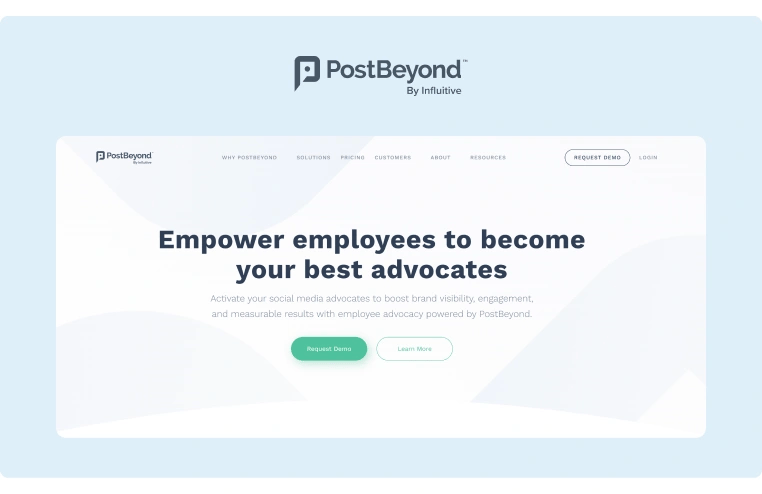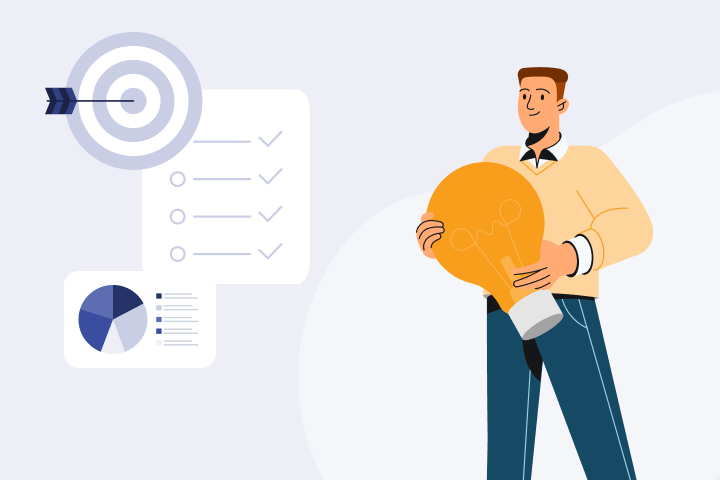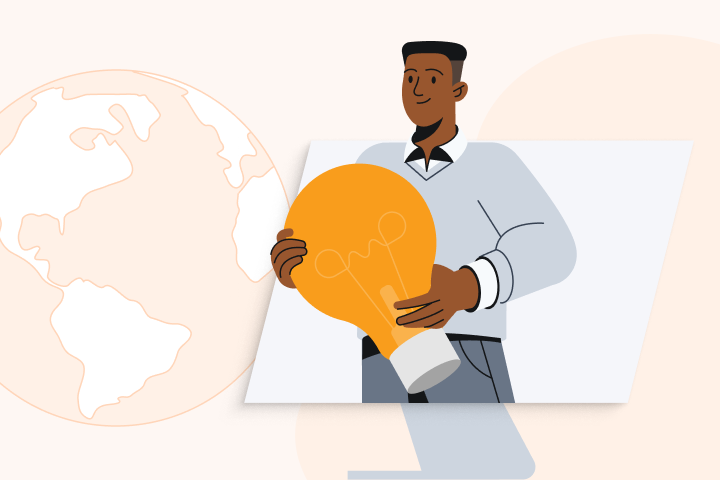A company’s most powerful asset is its employees, specifically motivated and engaged workers. By implementing an employee advocacy program, your brand can tap into its workforce’s powerful voice and social network to amplify your brand's reach and credibility.
But, before reaping the rewards of an employee advocacy program, there are some things you need to know (and have in place).
In this blog post, you’ll learn what is an employee advocacy program, how to craft an effective advocacy strategy and the best tools for the job, plus real-world examples to boost your team’s creativity and elevate your brand to new heights through strategic advocacy efforts.
Ready to get started? Let’s go!
What Is an Employee Advocacy Program?
An employee advocacy program helps transform your employees into passionate brand advocates who can amplify brand messaging, establish thought leadership, and attract potential leads.
The latter is particularly important. Research shows that companies with employee advocacy initiatives have leads that convert 7x more often. These programs foster authenticity and organic engagement, creating meaningful connections with your target audience, which attracts new customers and employees.
Employee Advocacy on LinkedIn
One of the best platforms to reap the fruits of your employee advocacy is LinkedIn. Employee advocacy on LinkedIn is when your employees expose their social networks to your brand’s messages. This can be done by either engaging with published brand content or creating content that aligns with brand initiatives.
In this example, a Buffer employee shares news that their company is hiring. Check out the number of reposts from this single post: that is the power of employee advocacy.

Source: Hailley Griffis
However, running a successful LinkedIn employee advocacy program can be challenging. Common obstacles include employees who don’t want to share work-related content, employees who don’t use social media, and employees who want to share but don’t know how.
Fortunately, these obstacles can be overcome with an employee advocacy strategy that will recognize employee advocates for their contributions and guide them on how to share and engage with the right content.
Crafting an Effective Employee Advocacy Strategy
Brands with the best employee advocacy programs know the importance of implementing an employee advocacy strategy.
Crafting a top-notch employee advocacy strategy is like sculpting a masterpiece — it requires careful planning and alignment with your goals. Here are some tips to help you create an effective employee advocacy strategy:
-
Define Objectives. Start by defining clear objectives aligned with your employee advocacy program. Are you aiming to enhance brand recognition, increase website traffic, or generate more leads?
-
Identify Target Audience. Determine who will use your product/service and how your brand can help them. This will help you create engaging, personable, and valuable content.
-
Select Target Platforms. Once you've established your goals and target audience, it's time to select your target platforms. Choose the platforms that your employees and prospects are most active on (e.g., LinkedIn).
-
Create Engaging Content. Create content that will resonate with your target audience (e.g., text with image posts, videos, articles, carousels). Sharing a mixture of informative articles, inspiring stories, and behind-the-scenes glimpses will help keep your advocacy efforts fresh and engaging.
-
Offer Training. Provide comprehensive training and resources to equip your team with the skills and knowledge needed to effectively advocate for your brand. Investing in your employees' development pays dividends in the long run.
-
Encourage Open Communication. Foster a culture of open communication and collaboration, encouraging employees to share their insights and feedback. Valuing their input not only strengthens their commitment but also fosters innovation within your organization.
-
Recognize Employee Contributions. Recognize and celebrate your employee advocates' contributions, whether through public acknowledgment, incentives, or personalized rewards. Acknowledging their efforts reinforces a culture of appreciation and motivates continued employee engagement.
-
Monitor Employee Advocacy Program. Continuously monitor and evaluate the performance of your advocacy program, using data-driven insights to refine and optimize your strategy. By staying agile and adaptable, you can ensure your program remains effective in an ever-evolving landscape.
This last tip is particularly important because it’s the reason why some brands’ employee advocacy programs soar while others flounder. According to employer branding expert Brian Butkowski, accurately measuring an employer brand’s success isn’t easy, but it can be done:
“It can be very difficult to accurately measure an employer brand’s success. The obvious keys are the rate of employee retention and the percentage of candidates who become hires. Most companies develop appropriate ways to test and score employee satisfaction and morale. This typically starts by conducting some kind of Employer Brand Audit.
The goal of these audits is simple: to discover if the activities the company deploys to shape their perception are making the desired impact. Once a baseline is established, it’s critical to routinely assess the employer brand’s success, and take the necessary actions to stay on track or aim to get even better.”
Now that you’re equipped with these tips, let’s take a look at some employee advocacy tools that brands with strong employee advocacy programs use.
Exploring Employee Advocacy Tools
Employee advocacy tools are designed to streamline your advocacy efforts, making it easier for your employees to share your brand's messaging. By choosing the right tools, you'll set your employee advocacy program up for success and empower your team to become true brand champions.
When selecting employee advocacy tools, it's essential to consider factors like scalability, integration capabilities, and alignment with your specific needs. Look for platforms that offer flexibility to grow with your business and seamlessly integrate with your existing systems.
Here are our top three employee advocacy tools:
1. Hootsuite Amplify

Hootsuite Amplify has a user-friendly design and a proven track record in driving employee engagement and brand visibility.
With this tool, your team can easily share content across multiple social media platforms, streamlining the advocacy process. Its scheduling capabilities allow employees to plan their posts in advance, ensuring consistent and timely sharing of brand messages.
It also offers detailed analytics and reporting tools, allowing you to track the performance of your advocacy efforts and identify areas for improvement.
2. PostBeyond

PostBeyond is an ideal choice for brands looking to streamline their employee advocacy efforts. With this tool, you can provide your employees with a one-stop shop for pre-approved content that they can easily share with their social networks.
Robust reporting and analytics can also help you determine which social posts are most engaging. To keep employee engagement high, its built-in gamification features (leaderboards and badges) incentivize active participation and foster healthy competition among employees.
3. GaggleAMP
GaggleAMP stands out as a top choice for a comprehensive employee advocacy platform, offering a wide range of features designed to maximize the impact of your advocacy program.
Its customizable campaigns allow brands to tailor their advocacy efforts to specific goals and target audiences. GaggleAMP's advanced analytics provide deep insights into employee engagement and content performance, enabling organizations to fine-tune their advocacy strategies for optimal results.
Additionally, its integration capabilities make it easy to connect with existing systems and workflows, ensuring seamless implementation and scalability. With its extensive feature set and focus on customization and analytics, GaggleAMP is our top recommendation for organizations looking to elevate their employee advocacy efforts and drive tangible business results.
What Are Some Examples of Employee Advocacy Programs?
Now that we’ve defined employee advocacy, reviewed some helpful advocacy strategy tips, and explored some employee advocacy tools, it’s time to see a few successful employee advocacy programs in action.
Here are some examples of successful employee advocacy programs that you can use for inspiration in your own strategy:
1. Starbucks
Starbucks has elevated employee advocacy to a new standard by affectionately calling their staff "Partners" and investing in their well-being and professional development. Their commitment to their employees includes fostering a culture of open communication and collaboration, where Partners are encouraged to share feedback and ideas.
This initiative not only boosts employee satisfaction but also enhances brand loyalty. Customers view Starbucks as a company that values its employees' voices. As a result, it’s no surprise that Starbucks was recognized by Fortune’s 2023 World’s Most Admired Companies list, ranking first in the Food Services Industry.

Source: Starbucks
2. Directive
Directive's employee advocacy shines through their "Player of the Week" posts on social media, which highlight team members, their roles, and personal interests, while emphasizing the supportive work culture. Each post features the employee's favorite part about working at Directive, along with public praise from colleagues.
With a collaborative atmosphere and a wealth of knowledge, employees feel empowered to share ideas, fostering a strong sense of community. This approach cements Directive's reputation as a place where people thrive and feel valued.

Source: Directive
3. Taskforce
Taskforce's posts featuring work anniversaries exemplify a robust employee advocacy program. To foster a world-class work environment, the company prioritizes regular team-building activities like rafting, paintball, and barbecue parties.
However, the true highlight is their 5 Year Anniversary Club, which epitomizes the sense of togetherness and family. When employees reach this milestone, they join the club and receive special gifts, reinforcing the company's commitment to celebrating and honoring its dedicated team members.

Source: Taskforce
4. Endor Labs
Endor Labs is a great example for brands that are looking to position themselves as the solution to a pain point. The cybersecurity company leverages its employee advocacy to create and share informative thought leadership content for companies who may experience vulnerabilities in software.
Here, Endor Labs shares a handy breakdown that introduces its audience to the world of vulnerability prioritization. By empowering its audience with relevant knowledge, the brand is making a positive impression with the goal of keeping Endor Labs top of mind for future cybersecurity needs.

Source: Endor Labs
Next Steps for Effective Employee Advocacy
Employee advocacy programs are not just about boosting your brand's visibility or attracting top talent — it's about empowering your workforce to become your brand's most enthusiastic ambassadors.
But, executing an employee advocacy strategy manually can be daunting, especially as employees juggle multiple tasks. That's where GaggleAMP steps in. Our platform streamlines your employee advocacy efforts, keeping your team actively engaged and ensuring your brand's message reaches far and wide.
Ready to take your employee advocacy program to the next level? Schedule a demo or jump into a free trial with GaggleAMP today! Let's unlock the full potential of your workforce together.











